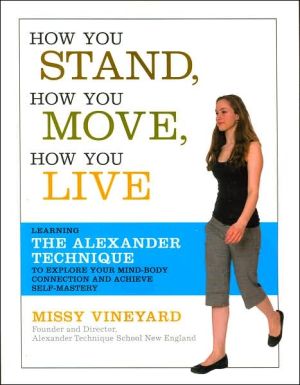

 |

|

The average rating for How You Stand, How You Move, How You Live: Learning the Alexander Technique to Explore Your Mind-Body Connection and Achieve Self-Mastery based on 2 reviews is 3.5 stars.
Review # 1 was written on 2009-06-04 00:00:00 Kevin Salter Kevin SalterThis book is an introduction to the Alexander Technique (A.T.). This technique was conceived of by Frederick Matthias Alexander, a 19th century stage actor who discovered a connection between our way of thinking and the effect it has on how we move. In his case, he developed a chronic problem with his throat that made it difficult to speak comfortably when performing. Over time his voice would become raspy and his throat would feel raw. So he visited a doctor who told him to stop performing for a while and drink lots of tea with honey. He did this and was able to return to the stage. Shortly after returning, his voice became a problem again. He went back to the doctor who advised that he stop performing again and drink more tea with honey. He then asked the doctor if there might be something that he was doing that was wrong and therefore hurting his throat. The doctor said it's possible, but had no suggestions. Since Alexander didn't want to stop acting, he decided to try some experiments, one of which was to watch himself in a mirror from various angles as he performed. He was shocked to discover that he had some unusual physical mannerisms that he was completely unaware of. That introductory story is followed by other stories about the author's (Missy Vineyard) students (she is one of the leading A.T. instructors in the U.S.). However, I won't go into that in the review. Instead I'll say that the book really does make some rather obvious but normally ignored points about how we move. Most of the time we're too busy to pay attention to every detail of how we move our bodies. As a result we take many shortcuts which become habits that we are unaware of. Just like my habit of sometimes saying "Umm..." as I formulate the next sentence while speaking, we all have habits in our movement that we have no conscious knowledge of. Some examples are; slouching, tensing muscles that aren't needed for a particular activity (think of how some people grit their teeth as they try to solve a difficult problem) or even trying to compensate for something like slouching by overextending our muscles incorrectly. Many of these habits can lead to very debilitating physical conditions as we age. This book teaches you how to become aware of how you move (she calls it a sixth sense, the sense of bodily movement) so that you can correct habits that might negatively impact you later. As she progresses in the book she proceeds from how to become conscious of our movement to the connection between our thoughts and our movement. One notion that she expands beyond what Alexander proposed originally, is that our thoughts control of movement, but not with just a single mind. Vineyard has the advantage of nearly 100 years of neurological scientific developments to help her with explaining why she believes that rather than conscious control of our movement, we're better off letting our more primitive portion of the brain (the amygdala) coordinate a lot and letting our prefrontal cortex (the conscious "thinking" part of the brain) simply direct. By direct, she means that our conscious contribution to movement should amount to nothing more than "go forward" instead of "put one foot in front of the other and watch where you're going". This may seem extremely obvious and farcical, but the full impact of changing your way of thinking regarding movement becomes a lot clearer as you read the book. Sadly, all is not well with the book. While she makes a lot of very interesting observations and I have found them to be of great benefit in changing both my ways of moving and my ways of thinking, she does delve into areas that many will regard as pseudoscience or even mysticism. She tries her best to avoid anything that sounds supernatural, but skeptical readers will likely paint her with that brush since they will likely not be able to relate to what she has to say about touch being a form of communication. (To the point that she could feel a student's depression every time she touched him and that it caused her to feel a strong pressure in her chest) This portion of the book comes in the last chapters, so it's well concealed based on earlier parts of the book that have some rational science (even if applied in sketchy ways) behind them. Thankfully, it is not essential to believe everything in the book and you can pick and choose what applies to your situation. I think it's best to approach the book as a series of mind experiments combined with a physical aspect and as I mentioned earlier I have benefited from that approach. So if you're inclined to altering your way of interacting with reality, this might be the book for you. |
Review # 2 was written on 2017-09-21 00:00:00 Richard Marion Richard MarionMostly descriptive, with a handful of exercises |
CAN'T FIND WHAT YOU'RE LOOKING FOR? CLICK HERE!!!